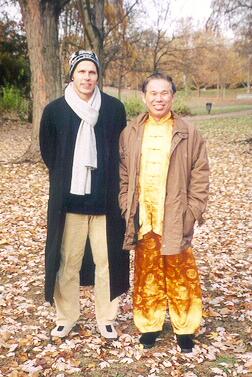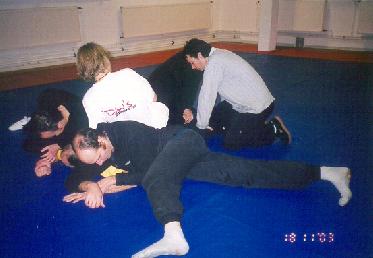DIM MAK OR DIAN XUE
Sifu Kai Uwe Jettkandt, Shaolin Wabnam German

Sifu Kai Uwe Jettkandt and Grandmaster Wong
Dim Mak which is in Cantonese Chinese, is also named Dian Xue, which is in Mandarin Chinese. Dian means to point with a finger or squeeze; and Xu means nerve point.
Dim Mak is one of the highest Shaolin Kung Fu Arts, which manipulates energy points on the human body. This is achieved by beating, pushing or squeezing. The use of this art form can lead to paralysis, unconsciousness or even to death.
In general
Dim Mak is the highest art form in Shaolin. In its highest training it also includes the art of healing and reanimation. Because of its dangerous impact, this art form was only transmitted to people who had an honorable character with high morals.
The founders of this high Shaolin art are not traceable anymore by name. However, there are records of Masters who were able to execute Dim Mak to perfection.
Zhang San Feng for example lived, studied and trained many years in the Shaolin Monastery. He then founded Wudang Kung Fu. It is said that Zhang San Feng had mastered the 36 deadly points of the human body to perfection through the unity of the 3 treasures of the human body, energy and mind.
Another name mentioned is Lu Tong (Qing dynasty), nicknamed Iron Leg, from the state of Lu, the birthplace of Confucius. He was once attacked by many strong adversaries and paralyzed them with his Dim Mak art. Since this happened publicly, there were many witnesses who saw this with their own eyes. After this confrontation Lu Tong re-opened the energy points of the attackers and as a result they were all again capable to walk or talk. Naturally everyone asked Lu Tong where he had learned the art of Dim Mak and he confirmed that he had acquired it in the Shaolin Monastery.
Knowledge
An extensive knowledge is necessary in order to master the art of Dim Mak. Mastering this high art form also includes the capability to heal. If you only master a few attack points and apply them, one could say that you are a long way from mastering this art.
In order to master the art of Dim Mak you need to study the meridians, the different points along them and the effect they have, as well as the times on the organ clock. The capability of re-opening these points, so that the danger on health and life can be averted, is of equal importance. The Master of Dim Mak should also have a certain repertoire of herbal formulas in order to dissolve inner Qi and blood blockages.
Just listing these few criteria, it becomes evident that in order to become a master in this art form requires many years, if not decades of training. It is not sufficient to just have the knowledge that certain blows, pushes or touches can result in the interruption of Qi or blood circulation.
Over the entire body there are 365 classical acupuncture points distributed. 108 points are studied in the Dim Mak art form, of which 72 points lead to deaf, paralysis or unconsciousness. 36 points are categorized as deadly points, which means that if no counter measures are taken within a short time frame or, alternatively, herbal remedies are taken. death can occur within minutes, hours or sometimes days. The time of death depends on the choice of points and the intention of the attack.
Many of the Dim Mak points are named differently than in the teachings of Acupuncture.
Mastering Dim Mak requires the deep knowledge of energy points and energy flow in the human body, the Qi, the blood and its application for healing and fighting.
This Dim Mak art is part of the inner, also called soft Kung Fu. It is part of the inner art form since the one practicing it must have a strong and free flowing Qi.
He is able to reach this through practicing the high Shaolin art form of Chi Kung, Nei Dan and Chan/ Zen. Through this all body parts, meridians and organs are freed from any blockages.
Once this first step is fulfilled the next step is to practice Shaolin Chi Kung which will result in increasing Qi potential, for example in Zhan Zhuang. After that the capability to direct Qi must be acquired, for example through "Yi Zhi Tu Chan" or "One-Finger Shooting Zen".
Developing Zen, meaning training of the mind, is an important part of the study as the mind directs the Qi. Through meditation we learn to observe the mind, free the mind and act free of emotions. Knowing your own mind also means knowing your emotions.
This is a very important aspect of the study of this particular Dim Mak art form, as being inattentive or acting emotionally can lead to severe injury and even to death. "Let mercy flow from your hand" is a critical mindset for the Dim Mak practitioner.
The highest mastership in Dim Mak is reached when the points can be manipulated without touch. This means that the energy point is "touched" energetically from a distance through, for example, "One-Finger Shooting Zen" and the effect is herewith achieved remotely.

Sifu Kai Uwe Jettkandt being pinned down by a few able-bodied men. He just stood up and the men fell off, demonstrating his internal force.
The Effect
The human body has an energy highway, the meridian system. Qi, or energy, flows through these meridians and supplies all parts of the body. Each meridian has many energy points which can be stimulated through acupuncture to achieve certain effects. There are 12 main and 8 special meridians. These meridians have a kind of "wedding" twice a day and this is when Qi is especially strong. This time is also called the organ time.
The Dim Mak practitioner will then ideally choose a Qi filled meridian and influence a chosen energy point, for healing purposes or for defense. The energetic manipulation of that particular point will then cause a stagnation of blood or Qi. As a result, the supply to particular extremities or organs may be interrupted, which can lead to paralysis, shortness of breath, unconsciousness and even to death.
Dim Mak Training
It is crucial for the chosen student, who must have high morals, to receive a well-structured training. The below list reflects the contents and sequence of a well-founded training. This list is compiled by myself to the best of my knowledge and experience. Some of these stages can be trained, studied and practiced in parallel.
Training phase I
- The course of the meridians
- Organ clock
- Localization of points
- Effects of points
- Chi Kung
- Nei Gong
- Zen
- Hand forms and other body parts respectively
- Exercises in order to strengthen those hand forms and body parts (inwardly/ outwardly)
- Test forms (tree leaves, candle, bricks, candle behind paper, candle behind glass etc.)
- Exercises for maksmanship (paper, wooden doll, sandbag), stationary
- Exercises for maksmanship drawing points (paper, wooden doll, sandbag), moveable
- Partner exercises, sequences, sets
- Learning of counter measurements and relief efforts in case of Dim Mak hits
- Study of herbal remedies for inner and surface injuries
One Finger Zen-Hand, Speer-Hand, Sword-Hand, Dragon-Hand, Phoenix-Eye, Elephant-Fist, Crane-Beak, Foot-Toe
Moral
Life is the highest gift for human kind. This is the moral background for every healer. Only someone who carries this in his heart should be admitted to the education and training of Dim Mak. Learning to heal and therefore improving the life of others is a good inner preparation to subsequently be admitted as a scholar to the teachings of Dim Mak.

Sifu Tim Franklin of England describing the effect of dim-mak
LINKS
